How to remove CryptoWallet Address Replacing Virus
TrojanAlso Known As: CryptoWallet Clipper malware
Get free scan and check if your device is infected.
Remove it nowTo use full-featured product, you have to purchase a license for Combo Cleaner. Seven days free trial available. Combo Cleaner is owned and operated by RCS LT, the parent company of PCRisk.com.
What is the CryptoWallet Address Replacing Virus?
CryptoWallet Address Replacing Virus refers to a system infection with a malicious program, which has clipper functionalities.
Clippers (also known as clipboard hijackers) are designed to change the data copied into the clipboard. In this article we will analyze clippers designed to replace copied cryptocurrency wallet addresses before an outgoing transaction - thereby redirecting the funds to cryptowallets belonging to the cyber criminals.
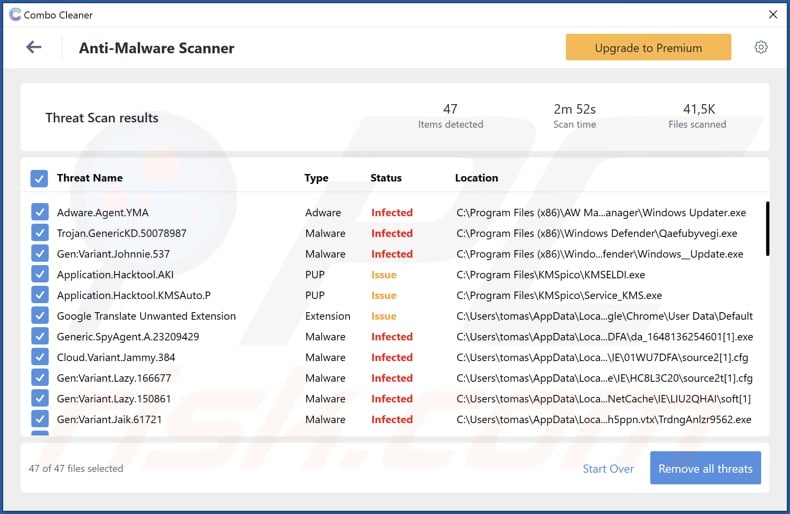
CryptoWallet Address Replacing Virus overview
Sophisticated clippers detect when a user has copied a cryptocurrency wallet address into their clipboard (i.e., copy-paste buffer). This malware's purpose is to change the copied data; hence, the cryptowallet address is replaced with one in possession of the cyber criminals.
Therefore, whenever victims make an outgoing transaction, instead of pasting the intended address, the clipper pastes a different digital wallet address - thereby diverting the cryptocurrency to the criminals. Although this trick is simple, it is quite effective. Cryptowallet addresses are simply combinations of letters and digits. For this reason, it is rather easy for victims not to notice that the copied string was replaced. These malicious programs most commonly target Bitcoin and Ethereum cryptocurrencies.
Clipper infections can cause significant financial losses. However, some malicious programs are multifunctional. Hence, replacing clipboard data is but one of their features - which means that they can pose additional threats.
If you suspect that your system is already infected with a CryptoWallet Address Replacing Virus, we strongly advise using an anti-virus to remove it without delay.
| Name | CryptoWallet Clipper malware |
| Threat Type | Trojan, Clipper, Clipboard Hijacker. |
| Detection Names (clipper example) | Gridinsoft (PUP.Win32.Gen.vb), SecureAge APEX (Malicious), SentinelOne (Static ML) (Static AI - Suspicious PE), Webroot (Riskware.Gen), Full List Of Detections (VirusTotal) |
| Detection Names (malicious installer example) | AhnLab-V3 (Infostealer/Win.PassStealer.C5162419), ESET-NOD32 (A Variant Of Win32/Packed.VMProtect.AC), Gridinsoft (Trojan.Heur!.00216431), SentinelOne (Static ML) (Static AI - Malicious PE), Sophos (Mal/VMProtBad-A), Full List Of Detections (VirusTotal) |
| Related Cyber Criminal Cryptowallet Addresses (Bitcoin - BTC) | FF8CxYAoizSNxLU9eYCfcCQnKR8QGxD4LuqeqH8hGVGf, bc1qg4zndrsatg0j6xzdc5czs9l3vntz5gwwsrp6py, 156UGALjatSQnY7wy4LruP6CEE5VoczdZE, 12CLn8QNN7twEuRJSXi8Na4VfzhAxWxDUn, 12nsFG3sMNKKfsovAkS92Mfrp2NYoMKX71, 17uoEtuihi6Lsg4hdedT7PUhF4FNgBPD2F, bc1q8h4v0d2ugj3c9hwfy87k0fhq7h3uwzsygc4m77, 18GPG1N7N6RR3bMiaDEneMzWPXKFBECqxq, 19NzchVhQV8dJ4N4Eq7HEXG9ff8qCoLbvE, 1CWBb7NyAqYGyj185m6fBzfg7wTMhZg6wS, 1DHFistZS5Y7U8zZfg4Ut72iAn1SVEf451, 1EU1jBxj8nKfvCaAzdeq1yafPEGrimcg8k, 3ACquHUrjAkTDgBKbKWyWdHyZabqYVkKk9, 3Ex2BJT2aiqDJKPAFeuWMbB4T6MhML384p, 3HHWUh6wLmX8AxHTGcQ7Q4uiEmicMCL8HL, 3N7gh7mg4hyxnwGTFUpjHfpZh154Eu7rYD, 3PxkHEMPaNMPMyiiHpHEj6ZgWzShh54N65, bc1q92xadetvvngcgu6cq9kfhd33flss7xch63wmrv, bc1qdhm0s0mgv08aa8k8j96dhzw23m7sh4x0as87yd, bc1qpakeevyhka6hwnlm0zhhcygy8ql8l3zrtzqmv2, bc1qslzv7hczpsatc8lq285gy38r4af0c3alsc4m77, 3H3zy8ETnvhMHotJvDAAF7Ftgkhq38Zrds, bc1qcyeekgu7wdnyanm5vtfjxsdwaqnuy36dxth80a, 1DorJz46uRfVvAtx3b2iyvaxdLiX9oe7Tp, 3P1DXpxbsY6ffanFNH39XSfz7sUqZCWHZm, 1LoY8VANe3V4XVEFepxasPxD5hMqMQLsn6, 1CsVZCTYNghfSFrvZeVcNXmXDLdPguswJ2, 1LbkbhV4vxoaVat868dF7teu3F6A8MwkFe, 17M9qGkwh81pZNNd1YhRx3gFtPpDnEMX71, 1CqCgq6zx3aqaTUnJScT8BXK4Vqw4GRfNa |
| Related Cyber Criminal Cryptowallet Addresses (Ethereum - ETH) | 0xD1C64f757929D10430BC93FDb4a7105d8AcaaF30, 0x7e022F7d612a50CA8cA7B25c5dedCbfD93848175, 0x07c23f1Eb79eB615A2e58FF3Db0A5DbDCE810b56, 0xC231Ac8f5C2B0048508d59e69EFF84Ed4247A268, 0x5a87F00A1dac28a285C7D336a1b29Fdc57b34115, 0xB6Bf364f64806fb71E8af1635C1E06273CB6Ba0d, 0xCf45E7346f604C883cE36AEAc6CaeC5f45f2fe09, 0x89E34Ee2016a5E5a97b5E9598C251D2a2746Ba0D, 0x9e701A56AA42cD89D4bD386c229Ed1A8e83E6257, 0xB626049946467c1D54a8B4740BD43cc5cdb2A6aa, 0xDA218fD737F6BBdC299c27c13418D55Da580c4a2, 0xEAC3ce292F95d779732e7a26c95c57A742cf5119, 0xc5aDE10a10a80e000fF9c3f8F2b187aCDaB55aE9, 0xd00634B22adAA771Be515527C33049dcfE6D0E3C, 0xf9c6f849011BD33AD95047Eefb920ee9B710214a, a286994afc2f28d5736e0bcab36bffee61be4aeb, 0x81319b34e571d8ae7725bd611bcb8c0b3556bf01, 0xb78F8934Ab22d773ee7c3a8c7FF708D059B579DF, 0x7B6E752213917517e2308117ECACd1c48880c152, 0xb68f82BFe302ef30a2327A99DB2Ae84633Bd9D77, 0x301EFaca86228E6a06F70172a1E86cc3768CE268, 0x1D1cbEd3EB8e719Cf563EC16f25445b434bcF26A |
| Related Cyber Criminal Cryptowallet Addresses (Other) | 16fbLF7urD5RHCiDvqSC1eM4r466SJCkfF5DTP9nKAKnaozi, AFq3RvPAbUApWTKMs6GESgHyhvtfLUe2Wr, DPRDs4jfzgCh8GTozDVwJaNo66g75arayV, FLoSwDjeNUaHe8VjfcFUtYtjwFc9YJsZxks64bb2QS7M5b8, GKQaCV4VVWxh5W1CfJ9FYAMmkncgpusLMLTZmEJerR3H, LP7x2Y6LGrtinfxWUTzVqqwnTUfFmYqWzr, MRbH25hg87qKvsKGZDL33XK7rjwfQ5vVzg, ND3GWLUHYL3GYYXV7BIXOZMEFLNUQFYU2I24OMMY, TAmTw5doYsPnRMpQfVUNziLW98oBwRqwAL, X-avax1e208qux8uvvv03dda63nkedphaqzh00g3a3fnv, Xk17a1AGPihft5uXuwbQdkhFzDdcpMgnUt, bnb1m0g0xl9w6nr33v2jgzq75a4we3y6g6kdmm902z, cosmos1xqly27s08fxf5k3sm3ug9mgrcuk4n4sn3mpeq4, f1e5ds447qhw6n45rav4osdwruplobk57t5ciwx7q, kava10y8ru0mstqqfsxfajz9mlc56q0nuyfehvqj4e5, qzym4hn476nc9es408jy6e5v7x5lzur2esaf240n8q, rJENdoViPfmhMXbufrPWp5FW9M7f4iVxgW, secret10q3wpsp7e9pcg0vhczsfzleyzv3av68c40g6xx, t1dRYFmiVyckLyNvxomCjhWgcocBJqEg4LA, terra1h880yegt32fhc28v46jsdfy99qmrleevxdyj4g, thor1m0e0x5dy3rtcp3dfgcwf5mxqs6vaj30flqn892, tz1himStzqAEXnpCZ3Q38tBq7EabR5WcbVYd, zil1a4y2hew0wvz9xuds6n6c6t5elaukgamy7k4vzd |
| Symptoms | Trojans are designed to stealthily infiltrate the victim's computer and remain silent, and thus no particular symptoms are clearly visible on an infected machine. |
| Distribution methods | Infected email attachments, malicious online advertisements, social engineering, software 'cracks'. |
| Damage | Stolen cryptocurrency, financial loss. |
| Malware Removal (Windows) |
To eliminate possible malware infections, scan your computer with legitimate antivirus software. Our security researchers recommend using Combo Cleaner. Download Combo CleanerTo use full-featured product, you have to purchase a license for Combo Cleaner. 7 days free trial available. Combo Cleaner is owned and operated by RCS LT, the parent company of PCRisk.com. |
Clipper malware examples
We have analyzed thousands of malicious programs and countless clippers. Allcome Clipper, Frost Clipper, Extended Clipper, ApocalypseClipper - are a few examples of clipboard hijackers, and Sorano Bot, MoistStealer, XLoader - of malware with clipper functionalities.
Malware often has varied features that are in different combinations. The most common functions include: data extraction (e.g., downloading files, obtaining passwords, keylogging, recording audio/video via microphones and webcams, etc.), data encryption/ screen-locking (ransomware), abuse of system resources to generate cryptocurrency (cryptominers), additional malware download/installation, and so forth.
Regardless of how malware operates, its presence on a system endangers device integrity and user safety. Therefore, it is paramount to eliminate all threats immediately upon detection.
How did CryptoWallet Address Replacing Virus infiltrate my computer?
Malware is spread using phishing and social engineering techniques. Malicious programs are usually disguised as or bundled with ordinary software/media. Infectious files can be archives, executables, PDF and Microsoft Office documents, JavaScript, etc. Once a virulent file is opened- malware download/installation is jumpstarted.
The most common distribution methods include: drive-by (stealthy and deceptive) downloads, malicious attachments and links in spam emails and messages, online scams (e.g., fake updates, hoax virus warnings, etc.), illegal program activation ("cracking") tools, and untrustworthy download sources (e.g., unofficial and freeware websites, Peer-to-Peer sharing networks, etc.).
How to avoid installation of malware?
We advise exercising caution with incoming mail. The attachments and links present in suspicious/irrelevant emails and messages must not be opened, as that can lead to a system infection.
Additionally, all downloads must be performed from official and verified channels. It is crucial to activate and update software with tools provided by legitimate developers - since illegal activation tools ("cracks") and fake updaters can contain malware.
We must emphasize the importance of having a reputable anti-virus installed and kept up-to-date. Security programs must be used to perform regular system scans and to remove detected threats and issues. If you believe that your computer is already infected, we recommend running a scan with Combo Cleaner Antivirus for Windows to automatically eliminate infiltrated malware.
Example of CryptoWallet Address Replacing malware's installation folder:
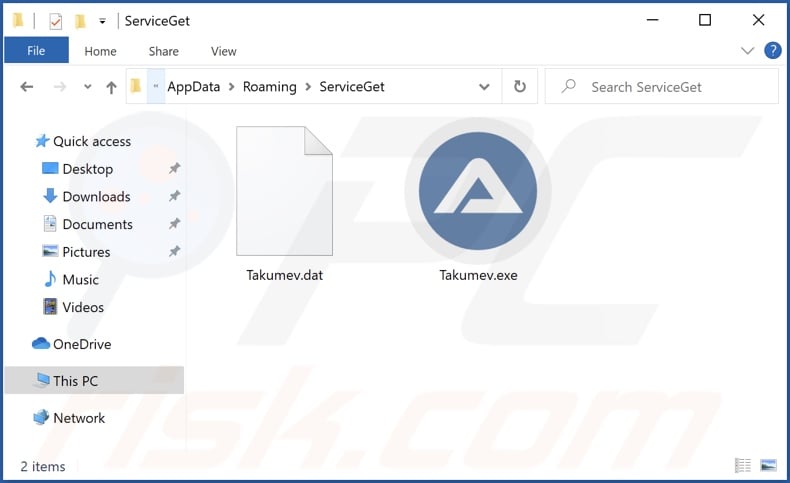
Example of CryptoWallet Address Replacing malware's process on Windows Task Manager:
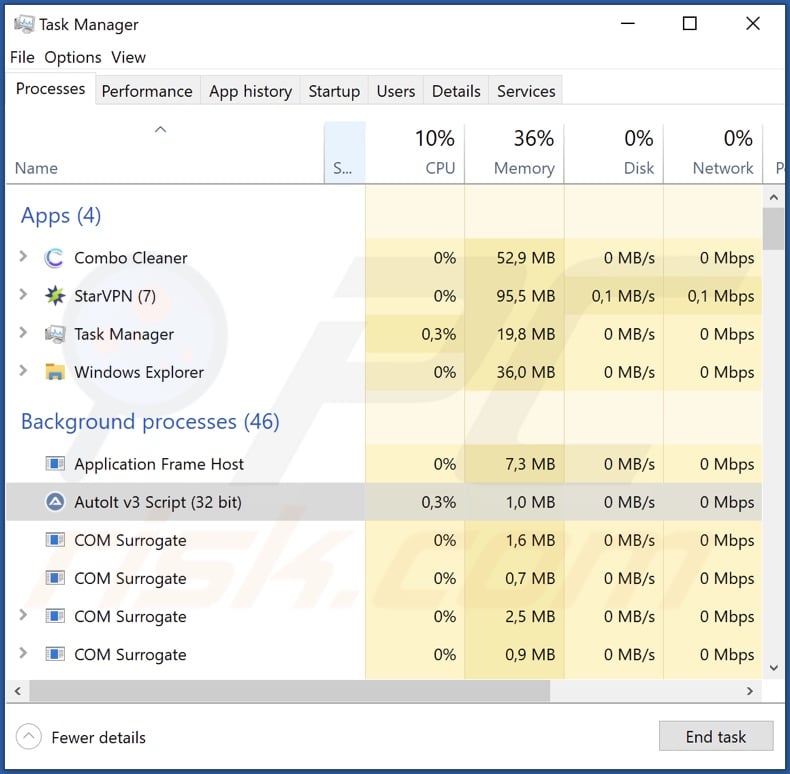
Example of CryptoWallet Address Replacing malware promoting website ("cracked" software download site):
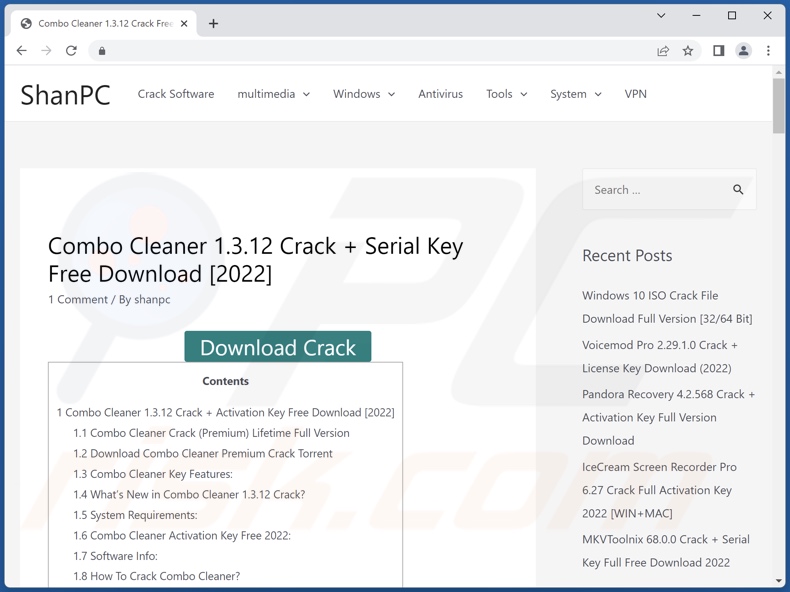
Appearance of CryptoWallet Address Replacing malware's functionality (GIF):
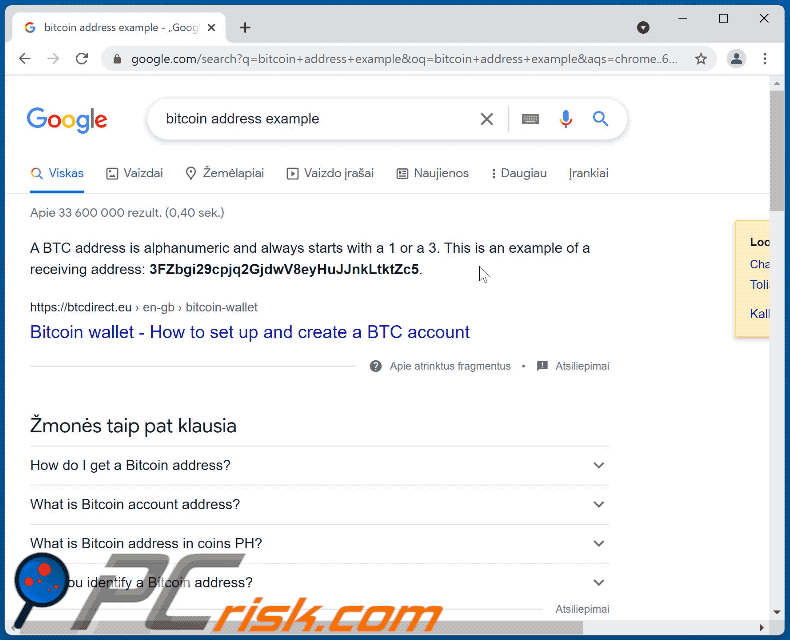
Update June 9, 2022 - new campaigns used to proliferate clipper malware have been discovered. Researchers at Avast had determined that these campaigns are successfully infecting thousands of users daily; areas of significant activity include Brazil, India, and Indonesia.
The infection chains begin with victims visiting a compromised "cracked" software download site (e.g., pirated office programs, video games, etc.). These websites have been observed holding the top positions in various search engines (including Google). When an attempt to download content is made, users are redirected to a malicious page that hosts the malware.
It is noteworthy that the clippers spread through these campaigns are often bundled with data-stealing malware. More information can be found in an article by Pavel Novak on blog.avast.com.
Update 29 March 2023 - In recent developments, there has been an emergence of crypto wallet address replacing malware that exploits the Tor Browser - a tool used to access the dark web through the Onion protocol (also known as the Tor network). The Tor Project website was banned in Russia towards the end of 2021, which the Tor organization confirmed.
To help Russian users circumvent this censorship, the Tor Project requested assistance. This led to malware creators distributing trojanized Tor Browser bundles among Russian-speaking users. While the first instances of these malware variants were seen in December 2021, a larger wave of the torbrowser_ru.exe malicious executables was not detected until August 2022.
Trojanized Tor Browser bundles are known to have the greatest impact in countries such as Russia, Ukraine, United States, Germany, Uzbekistan, Belarus, China, Netherlands, United Kingdom, and France. It is probable that the trojanized installer is distributed through torrent downloads or other software downloaders.
Instant automatic malware removal:
Manual threat removal might be a lengthy and complicated process that requires advanced IT skills. Combo Cleaner is a professional automatic malware removal tool that is recommended to get rid of malware. Download it by clicking the button below:
DOWNLOAD Combo CleanerBy downloading any software listed on this website you agree to our Privacy Policy and Terms of Use. To use full-featured product, you have to purchase a license for Combo Cleaner. 7 days free trial available. Combo Cleaner is owned and operated by RCS LT, the parent company of PCRisk.com.
Quick menu:
- What is CryptoWallet Address Replacing Virus?
- STEP 1. Manual removal of CryptoWallet Address Replacing Virus malware.
- STEP 2. Check if your computer is clean.
How to remove malware manually?
Manual malware removal is a complicated task - usually it is best to allow antivirus or anti-malware programs to do this automatically. To remove this malware we recommend using Combo Cleaner Antivirus for Windows.
If you wish to remove malware manually, the first step is to identify the name of the malware that you are trying to remove. Here is an example of a suspicious program running on a user's computer:

If you checked the list of programs running on your computer, for example, using task manager, and identified a program that looks suspicious, you should continue with these steps:
 Download a program called Autoruns. This program shows auto-start applications, Registry, and file system locations:
Download a program called Autoruns. This program shows auto-start applications, Registry, and file system locations:

 Restart your computer into Safe Mode:
Restart your computer into Safe Mode:
Windows XP and Windows 7 users: Start your computer in Safe Mode. Click Start, click Shut Down, click Restart, click OK. During your computer start process, press the F8 key on your keyboard multiple times until you see the Windows Advanced Option menu, and then select Safe Mode with Networking from the list.

Video showing how to start Windows 7 in "Safe Mode with Networking":
Windows 8 users: Start Windows 8 is Safe Mode with Networking - Go to Windows 8 Start Screen, type Advanced, in the search results select Settings. Click Advanced startup options, in the opened "General PC Settings" window, select Advanced startup.
Click the "Restart now" button. Your computer will now restart into the "Advanced Startup options menu". Click the "Troubleshoot" button, and then click the "Advanced options" button. In the advanced option screen, click "Startup settings".
Click the "Restart" button. Your PC will restart into the Startup Settings screen. Press F5 to boot in Safe Mode with Networking.

Video showing how to start Windows 8 in "Safe Mode with Networking":
Windows 10 users: Click the Windows logo and select the Power icon. In the opened menu click "Restart" while holding "Shift" button on your keyboard. In the "choose an option" window click on the "Troubleshoot", next select "Advanced options".
In the advanced options menu select "Startup Settings" and click on the "Restart" button. In the following window you should click the "F5" button on your keyboard. This will restart your operating system in safe mode with networking.

Video showing how to start Windows 10 in "Safe Mode with Networking":
 Extract the downloaded archive and run the Autoruns.exe file.
Extract the downloaded archive and run the Autoruns.exe file.

 In the Autoruns application, click "Options" at the top and uncheck "Hide Empty Locations" and "Hide Windows Entries" options. After this procedure, click the "Refresh" icon.
In the Autoruns application, click "Options" at the top and uncheck "Hide Empty Locations" and "Hide Windows Entries" options. After this procedure, click the "Refresh" icon.

 Check the list provided by the Autoruns application and locate the malware file that you want to eliminate.
Check the list provided by the Autoruns application and locate the malware file that you want to eliminate.
You should write down its full path and name. Note that some malware hides process names under legitimate Windows process names. At this stage, it is very important to avoid removing system files. After you locate the suspicious program you wish to remove, right click your mouse over its name and choose "Delete".

After removing the malware through the Autoruns application (this ensures that the malware will not run automatically on the next system startup), you should search for the malware name on your computer. Be sure to enable hidden files and folders before proceeding. If you find the filename of the malware, be sure to remove it.

Reboot your computer in normal mode. Following these steps should remove any malware from your computer. Note that manual threat removal requires advanced computer skills. If you do not have these skills, leave malware removal to antivirus and anti-malware programs.
These steps might not work with advanced malware infections. As always it is best to prevent infection than try to remove malware later. To keep your computer safe, install the latest operating system updates and use antivirus software. To be sure your computer is free of malware infections, we recommend scanning it with Combo Cleaner Antivirus for Windows.
Frequently Asked Questions (FAQ)
My computer is infected with CryptoWallet Address Replacing Virus malware, should I format my storage device to get rid of it?
No, malicious programs that replace cryptocurrency addresses (clipboard data) do not require formatting to be removed.
What are the biggest issues that CryptoWallet Address Replacing Virus malware can cause?
Malware of this type aims to redirect outgoing cryptocurrency transactions to wallets owned by cyber criminals. However, these programs can have additional features. Hence, malware with clipper (clipboard data replacement) abilities may also cause multiple system infections, data loss, serious privacy issues, significant financial losses, and identity theft.
What is the purpose of CryptoWallet Address Replacing Virus malware?
These malicious programs are designed to generate revenue, which is the primary purpose of malware in general. Malicious software can also be used to amuse the attackers, disrupt processes (e.g., websites, services, organizations, companies, etc.), carry out personal vendettas, or launch politically/geopolitically motivated attacks.
How did CryptoWallet Address Replacing Virus malware infiltrate my computer?
Malware is mainly proliferated via drive-by downloads, online scams, spam emails/messages, freeware and third-party download websites, P2P sharing networks (e.g., Torrent clients, eMule, etc.), illegal software activation ("cracking") tools, and fake updates. Furthermore, some malicious programs are capable of self-spreading through local networks and removable storage devices (e.g., USB flash drives, external hard drives, etc.).
Will Combo Cleaner protect me from malware?
Yes, Combo Cleaner can detect and eliminate most of the known malware infections. It must be stressed that running a complete system scan is essential - since high-end malicious software typically hides deep within systems.
Share:

Tomas Meskauskas
Expert security researcher, professional malware analyst
I am passionate about computer security and technology. I have an experience of over 10 years working in various companies related to computer technical issue solving and Internet security. I have been working as an author and editor for pcrisk.com since 2010. Follow me on Twitter and LinkedIn to stay informed about the latest online security threats.
PCrisk security portal is brought by a company RCS LT.
Joined forces of security researchers help educate computer users about the latest online security threats. More information about the company RCS LT.
Our malware removal guides are free. However, if you want to support us you can send us a donation.
DonatePCrisk security portal is brought by a company RCS LT.
Joined forces of security researchers help educate computer users about the latest online security threats. More information about the company RCS LT.
Our malware removal guides are free. However, if you want to support us you can send us a donation.
Donate
▼ Show Discussion